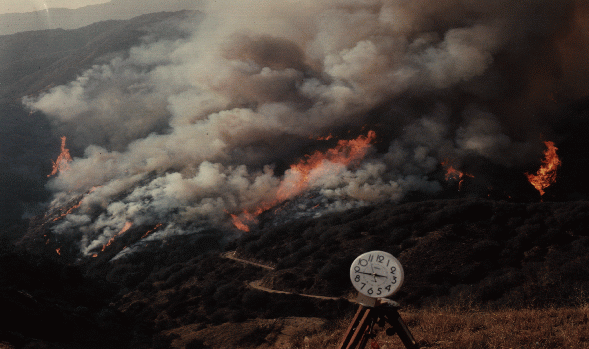| This research was undertaken as part of the thesis work
for my Master's degree at the Department of Geography, The University of Iowa.
This photograph shows one of the experimental fires set on the test watershed in the fall of 1984. Images:To look at some of the images created as part of this research, please click on the appropriate links: Abstract:Runoff and sediment yield processes in high-energy, mountain watersheds reflect the effects of extreme spatio-temporal variabilities in topographic, surficial, hydrological, and meteorological conditions. The extreme variability associated with such watersheds is further intensified in those areas where fire plays a significant role in watershed dynamics. Though several watershed models have been developed to advance our understanding, estimation and prediction of runoff and sediment yield for a variety of watershed types and conditions, efforts to specifically model fire-impacted, high-energy mountain watersheds have been limited to date. ANSWERS (Areal Nonpoint Source Watershed Environment Response Simulation) is a deterministic, distributed-parameter model that was originally developed for simulating runoff and sediment yield from Midwestern watersheds. Subsequently, it has been successfully applied to a much broader range of conditions. The purpose of this study was to assess the potential of ANSWERS to be adapted for modeling runoff and sediment yield in high-energy, mountain environments, and in particular, to assess the ability of ANSWERS to accommodate fire- effects in such environments. Bell4, a small mountain watershed located within the San Dimas Experimental Forest (SDEF), California, was selected as the test watershed for this study. Spatial data for the watershed, derived from the Pacific Southwest Forest and Range Experiment Station of the Forest Service of the US Department of Agriculture, were digitized and edited with ARC/INFO, converted into GRASS raster format, and processed by GRASS programs to create necessary inputs for ANSWERS. The study then endeavors to test the effect of the input data grid cell size on ANSWERS output, to determine the sensitivity of the model to specific input parameters, to evaluate the performance of the model by a comparison between the model simulated hydrographs and the hydrographs recorded for the watershed, and to assess the ability of the model to capture the effects of fire on runoff and sediment yield in the study watershed. Though ANSWERS was originally designed for modeling gently-sloping, agricultural watersheds, the findings of this study suggest that the model, despite some of its present constraints, can be adapted for modeling runoff and sediment yield in fire-impacted, high-energy mountain watersheds. In addition, the findings also suggest that elements of ANSWERS could serve as the core a new model specifically designed for use in fire-impacted, high-energy mountain environments. Researcher:
Advising Committee:
Acknowledgment(c) Copyright 1996-2006 M. Sayeeduzzaman |
